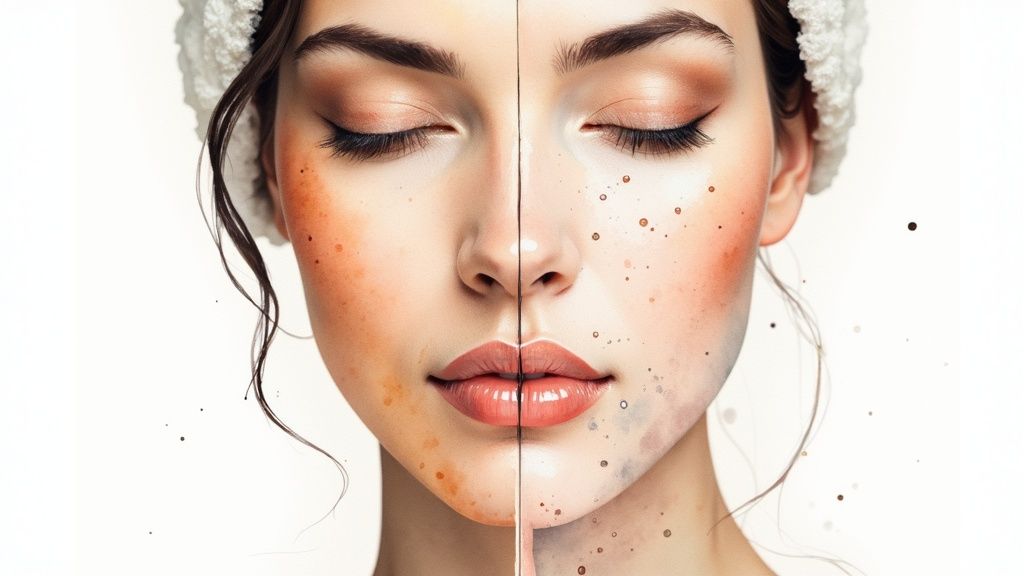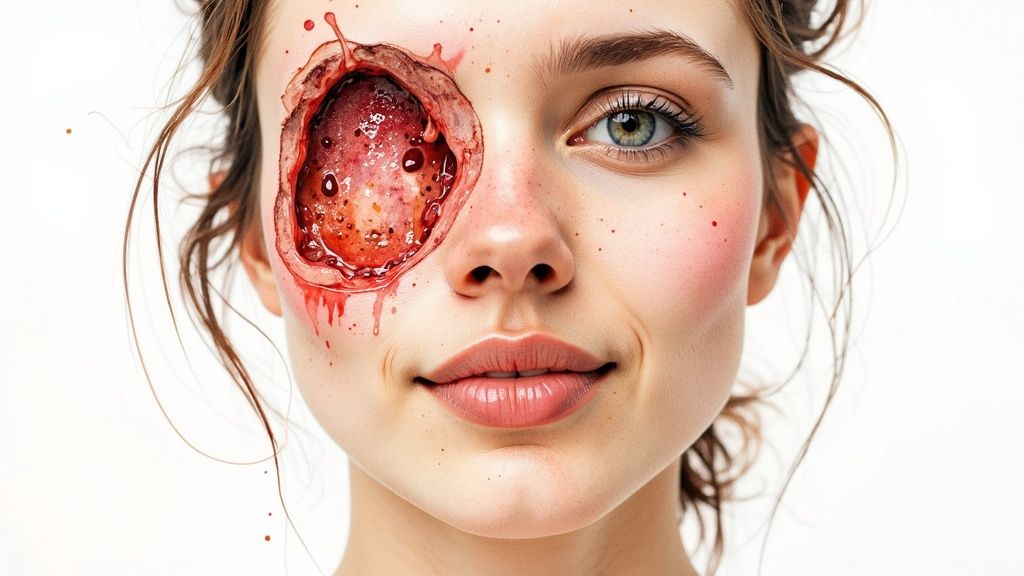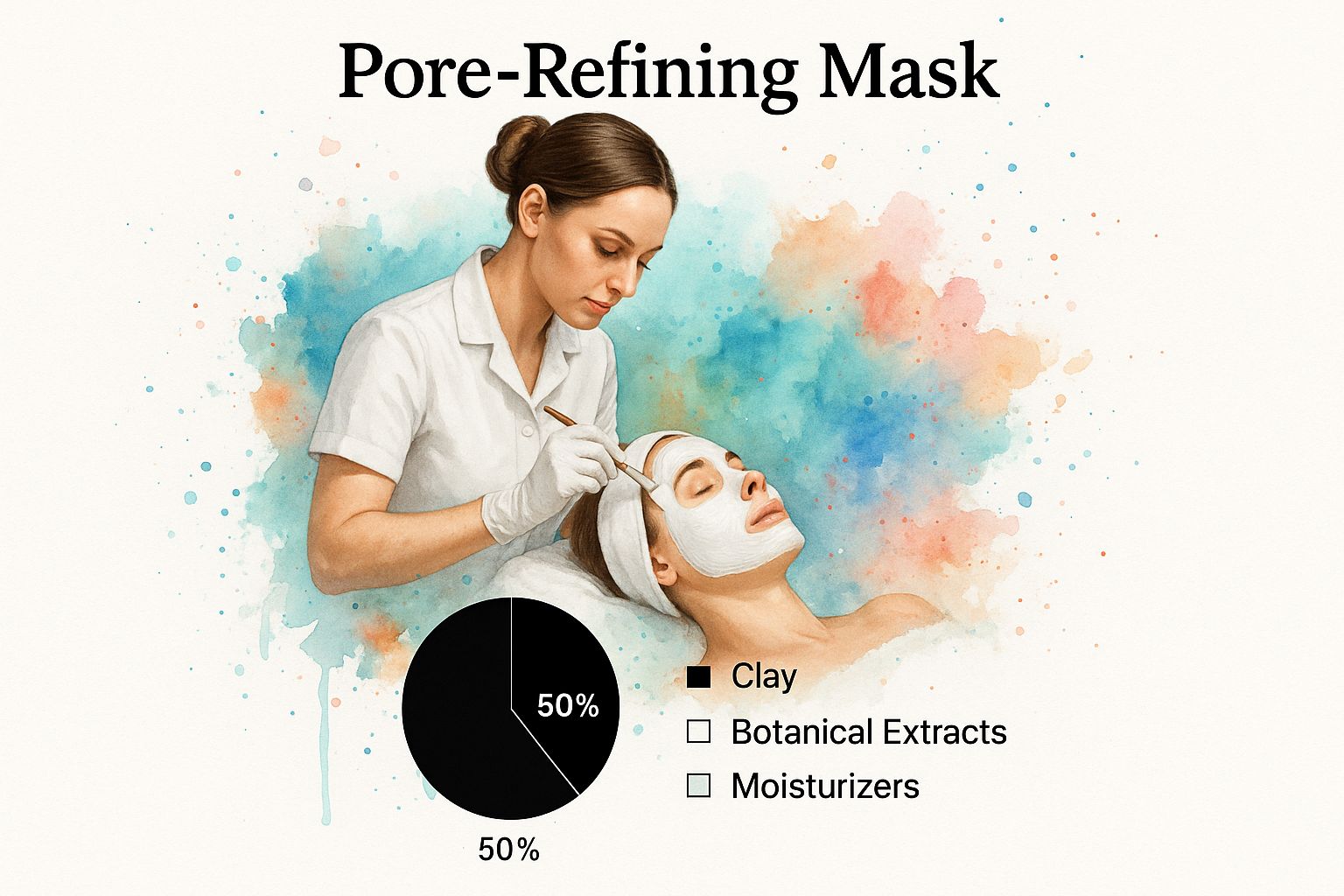
Your Guide to Facial Treatment for Large Pores
Before we dive into the best professional treatments, let's get to the bottom of why pores look bigger in the first place. You're not just imagining it—genetics, skin type, and the simple passage of time are the main reasons pores can become more noticeable.
Why Your Pores Look Larger Than You Want

Pores are just the tiny openings on your skin where hair follicles live. Their fundamental size is written into your DNA. While you can't change your genes, a few key things can happen that make these little openings appear much more prominent. Figuring out why they look enlarged is the first and most important step to effectively minimizing them.
A major player here is excess sebum (your skin's natural oil). When your oil glands are overactive, that extra oil mixes with dead skin cells and daily grime, creating a stubborn plug. This blockage literally stretches the pore, making it look much larger than it is.
How Skin Structure and Clogging Affect Pores
Imagine the collagen and elastin in your skin as a tight, supportive net holding everything in place, including the walls of your pores. As we get older, our bodies produce less of these crucial proteins. Sun damage is a huge culprit here, as it speeds up the breakdown of this "scaffolding."
When that support system weakens, the walls of the pores start to lose their tension and sag a bit, causing them to appear wider. This is a big reason why pores often become more of a concern with age, even for people who don't have traditionally oily skin.
Think of it this way: a clogged pore is like an overstuffed bag. The contents—oil and dead skin cells—stretch the opening, making it look bigger and creating a rougher texture on the surface.
This cycle of clogging and stretching can be incredibly frustrating. For a more detailed look into this process, you can explore our guide that breaks down what causes clogged pores. The main takeaway is that anything causing congestion will inevitably make pores look worse.
Key Factors That Influence Pore Size
A few different elements team up to determine how visible your pores are. Pinpointing which of these are at play for you is the secret to choosing the most effective facial treatment for large pores.
- Genetics: First and foremost, the skin type you were born with dictates your baseline pore size.
- Excess Sebum Production: If you have oily skin, you're naturally more susceptible to clogs that stretch out pores.
- Loss of Skin Elasticity: As we age and accumulate sun damage, the collagen that keeps pores tight breaks down, causing them to slacken.
- Hair Follicle Volume: It’s a simple fact that thicker hair follicles correspond to larger openings on the skin's surface.
Once you identify the main driver behind your enlarged pores—whether it's oil, a loss of firmness, or a mix of everything—you can zero in on a professional treatment that tackles the problem at its root for real, lasting results.
Your Professional Treatment Options at a Glance
When you’re staring down enlarged pores in the mirror, navigating the world of professional skincare can feel a little intimidating. The good news? You have some seriously effective options that deliver results far beyond what your at-home routine can.
These treatments generally tackle the problem from two different angles.
First, you have the resurfacing treatments. Think of these as a deep reset for your skin's surface. Procedures like chemical peels and microdermabrasion focus on clearing away the gunk—the dead skin cells and oily debris that get trapped and stretch out your pores. By sloughing off that top layer, they not only unclog what’s already there but also kickstart cell turnover for a smoother, more refined texture.
Then there are the treatments that work from the inside out, rebuilding your skin’s structural integrity. Collagen-boosting therapies like microneedling and lasers create tiny, controlled injuries deep within the skin. This cleverly triggers your body’s natural healing cascade, leading to a surge of fresh collagen and elastin. The result is firmer, plumper skin that effectively tightens and supports the pore walls from within.
Comparing Your Treatment Pathways
To help you figure out which path is right for you, let’s break down these powerful treatments. Each one brings something unique to the table when it comes to shrinking the appearance of pores.
This is where an esthetician's expertise really shines—blending science with a delicate touch to achieve that smooth, refined complexion.

The image above perfectly captures how a skilled professional combines deep knowledge with precise technique to make a real difference in skin texture and pore size. And it's no surprise that more people are seeking out these solutions.
The global market for facial treatments is currently valued at USD 1.25 billion and is expected to grow by about 7% annually through 2031. This isn't just a fleeting trend; it shows a real consumer demand for skincare that works. You can dive deeper into the numbers in this detailed industry report. This growth is fantastic news for us, as it drives innovation and leads to even more effective ways to get that flawless finish.
Key Takeaway: The best treatments go beyond a simple deep clean. They tackle the root causes of enlarged pores—like lost elasticity and dead skin buildup—for results that are both visible and long-lasting.
Professional Pore-Minimizing Treatments at a Glance
To give you a clearer picture, I've put together a quick comparison of the most common and effective professional options. This table should help you see how they stack up against each other.
| Treatment Type | How It Works | Best For | Typical Downtime |
|---|---|---|---|
| Chemical Peels | Uses acids to dissolve dead skin cells and unclog pores. | Oily skin, congestion, and mild texture issues. | 1-7 days of peeling. |
| Microdermabrasion | Physically exfoliates the top layer of skin with fine crystals. | Dullness and surface-level texture concerns. | None to 24 hours. |
| Microneedling | Creates micro-injuries to stimulate collagen production. | Loss of firmness and age-related pore enlargement. | 1-3 days of redness. |
| Laser Therapy | Uses light energy to resurface skin and build collagen. | Stubborn texture, sun damage, and significant sagging. | 3-10 days, depending on laser intensity. |
Ultimately, choosing the right treatment depends on your specific skin concerns, budget, and how much downtime you're comfortable with. It's always best to have a conversation with a qualified esthetician or dermatologist to create a plan that’s tailored just for you.
Giving Your Skin a Fresh Start with Peels and Microdermabrasion

When the main things making your pores look bigger are congestion and a buildup of dead skin, the best game plan is to resurface that top layer. Think of it like polishing a tarnished piece of silver—you gently remove the dull, rough exterior to reveal the bright, smooth surface underneath. That's exactly the logic behind chemical peels and microdermabrasion.
These treatments are cornerstones in professional skincare for a reason. They excel at "ungluing" and sweeping away the gunk that physically stretches out pores, leading to an immediate improvement in texture and a noticeable reduction in how large your pores look.
How Chemical Peels Unclog Pores From the Inside Out
A chemical peel is a seriously effective facial treatment for large pores. It uses specific acids to dissolve the "glue" that holds dead skin cells together on the surface of your skin. This is a form of controlled chemical exfoliation that goes way deeper than any scrub you could use at home. Instead of you doing the scrubbing, the peel solution does all the heavy lifting, melting away that stubborn mix of oil and dead cells clogging your pores.
One of the best things about peels is that they can be customized. Your esthetician will choose different acids to target exactly what your skin needs.
- Glycolic Acid: This is an alpha-hydroxy acid (AHA) that's incredible for overall renewal. It helps shed that dull top layer, evening out your skin's texture and giving it a fresh start.
- Salicylic Acid: As a beta-hydroxy acid (BHA), this is the MVP for oily and acne-prone skin. Because it's oil-soluble, it can get deep down inside the pore to break up sebum and clear out blockages from the source.
There's a huge link between managing acne and keeping pores clear. The global market for acne treatments is valued at a massive USD 10.45 billion, and that's partly because acne-prone skin often struggles with more visible pores. You can dig into the data on this growing market and how treatments target oil production in this comprehensive market analysis. It all comes down to this: get oil under control, and your pores will thank you.
A professional peel is like hitting the reset button on your skin's surface. By clearing out all the existing congestion and kickstarting fresh cell turnover, it allows pores to shrink back to their natural, smaller-looking state.
After a peel, it's normal to see some light flaking for a few days as the old skin makes way for the new. To get a real sense of the journey and the amazing results, take a look at our guide on what to expect from a chemical peel before and after.
Physically Buffing Your Skin with Microdermabrasion
If you think of a chemical peel as a deep chemical cleanse, then microdermabrasion is its physical counterpart. This treatment is like a very gentle, highly controlled sandblasting for your skin. A special tool sprays a fine stream of exfoliating crystals onto your face while a vacuum simultaneously sucks them—and all the dislodged dead skin cells—away.
This buffing action instantly smooths the skin and clears out any superficial debris hanging around the openings of your pores. It’s generally a less intense option than a peel and has little to no downtime, making it a great choice for a quick refresh. While a single session won't go as deep as a chemical peel, a series of microdermabrasion treatments can make a big difference in your skin's texture and clarity, helping to keep pores clean and less obvious over time.
Rebuilding Collagen with Lasers and Microneedling
While resurfacing treatments are fantastic for a quick reset, some of the most powerful solutions for enlarged pores work on a much deeper, more structural level. If you've noticed your pores looking more prominent due to a loss of skin firmness, then rebuilding your skin’s foundational support system is the best game plan. This is exactly where advanced treatments like lasers and microneedling shine.
Instead of just clearing out the gunk from the surface, these procedures get to work within the deeper layers of the skin, kicking off a powerful regenerative response. Think of it like renovating a house from the inside out. By reinforcing the underlying framework, you create a smoother, tighter exterior. This approach delivers more dramatic and lasting results, especially for age-related pore enlargement.
How Laser Treatments Remodel Skin
Laser resurfacing is a highly effective facial treatment for large pores that uses focused light energy to make a real difference. A specialized laser creates thousands of microscopic treatment zones deep in the skin, strategically leaving the surrounding tissue untouched. This clever technique initiates a robust healing cascade.
Your body sees these controlled micro-injuries and immediately gets to work, ramping up the production of new, healthy collagen. This fresh collagen literally rebuilds and reinforces the skin’s structure from within. As the tissue around each pore tightens up, the opening appears significantly smaller. Different types of lasers, like CO2 or fractional lasers, can be used depending on how intensive you want the treatment to be and how much downtime you're comfortable with.
By stimulating collagen synthesis deep within the dermis, laser treatments don't just clear pores—they fundamentally change the skin's architecture for a firmer, more refined texture that lasts.
To keep that collagen-building momentum going between professional appointments, you could also look into at-home red light therapy devices, which can help support overall skin vitality.
Stimulating Natural Repair with Microneedling
Microneedling takes a more mechanical approach to get to that same collagen-boosting goal. The treatment uses a device with ultra-fine needles to create tiny, invisible punctures in the skin’s surface. Just like with lasers, your body perceives these as minor injuries and immediately activates its natural repair mechanisms.
This healing process floods the area with growth factors and signals the production of brand-new collagen and elastin—the two proteins absolutely essential for firm, supple skin. As this new structural matrix forms, the skin becomes denser and more elastic. That added "scaffolding" helps to physically shrink the appearance of enlarged pores.
Because it taps into the body's own incredible regenerative abilities, microneedling is an excellent way to improve overall skin texture and firmness. You can dive deeper into how this all works in our in-depth guide to microneedling collagen induction therapy. It’s a truly powerful way to tackle concerns that stem from lost elasticity.
Your Skin, Your Pores: Why Age and Genetics Matter
When you're trying to find the right facial for large pores, it's easy to get lost in all the options. But here’s the secret: the "best" treatment isn't a one-size-fits-all solution. It all comes down to your unique skin biology, which is a combination of your genetics and your age. Getting this part right is the first step toward results you'll actually love.
Believe it or not, your family tree has a lot to say about your pore size. Genetics can absolutely predispose you to having more visible pores, and scientific research backs this up. One fascinating multiethnic study of 960 people found that pore size varies quite a bit across different ethnicities. For instance, people from places like India and Japan often reported having larger pores, which really drives home how much genetics are at play. You can dig into the research yourself and see how ethnicity impacts skin characteristics.
What this means for you is simple: a treatment that works miracles for a friend might not be the right fit if your pore concerns are rooted in a totally different genetic makeup.
The Aging Factor: Why Pores Seem to Get Bigger Over Time
Genetics aside, there's another major player in the game: time. As we age, our skin's natural production of collagen and elastin starts to slow down. Think of these proteins as the internal "scaffolding" that keeps your skin firm and holds the walls of your pores tight.
When that supportive structure weakens, the pore openings lose their taught, circular shape and can start to sag or stretch. This is why many people suddenly notice their pores in their 30s and 40s, even if they never had particularly oily skin before. It’s a completely normal part of the aging process.
For more mature skin, the most effective game plan is to rebuild that collagen from the inside out. Treatments like microneedling or certain laser therapies are fantastic for this because they stimulate your skin to create new, healthy support structures, essentially tightening pores from within.
This is exactly why a one-on-one consultation with a knowledgeable esthetician is so important. They can take a close look at your skin, factor in your age and genetics, and build a plan that gets to the real root of your pore concerns. It’s about investing in a solution that’s truly designed for you.
Protecting Your Investment After Treatment
Think of your professional facial as the major reset button for your skin. It does the heavy lifting. But the real, lasting change? That happens with what you do every single day at home.
Your at-home routine is what locks in those results and keeps your pores looking their best long after you've left the spa.
The First Few Days: Handle with Care
Right after a treatment, your skin is in a delicate, sensitized state. It's working hard to heal and regenerate, so you need to be gentle.
This is the time to baby your skin. Swap out any harsh scrubs for a mild, pH-balanced cleanser. Slather on a simple, soothing moisturizer that won't clog your pores (look for "non-comedogenic" on the label). And most importantly, sunscreen is absolutely non-negotiable. Freshly treated skin is extra vulnerable to UV rays, and sun damage can undo all the progress you just made.
Building a Long-Term Maintenance Plan
Once your skin is back to normal, it's time to build a smart, consistent routine. This isn't about throwing a dozen products at your face; it's about using a few key ingredients that work to keep pores clear and tight.
Here are the heavy hitters you'll want on your team:
- Retinoids: These vitamin A powerhouses are famous for speeding up cell turnover. This keeps dead skin from building up and getting trapped in your pores.
- Niacinamide: Think of this form of vitamin B3 as a personal trainer for your pores. It helps improve skin elasticity, which tightens up the pore lining, and it's brilliant at keeping oil production in check.
- BHAs (like salicylic acid): If you have oily skin, salicylic acid is your best friend. It’s oil-soluble, meaning it can dive deep inside the pore to break up all that gunk and sebum.
The secret to great aftercare isn't a complicated, 10-step routine. It's about consistently using a few targeted products that keep your pores clean and support your skin's underlying health.
After you've invested in a professional treatment, keeping your skin healthy is what makes it all worthwhile. Consider incorporating beneficial skincare products like Vitamin C Serum to help boost collagen and give your skin an overall glow.
This kind of proactive care ensures the amazing results from your facial aren't just a temporary fix. By committing to a simple but effective plan, you're truly protecting your investment and setting yourself up for smoother, more refined skin for the long haul.
Your Top Questions About Pore Treatments, Answered
It's completely normal to have questions when you're exploring professional skincare. You're making an investment in your skin, and you want to be sure you're on the right path. Let's tackle some of the most common questions people have about getting facial treatments for large pores.
This is all about setting realistic expectations and understanding what it takes to keep your skin looking smooth and refined for the long haul.
Can You Permanently Get Rid of Large Pores?
Here's the straight answer: no. We can't actually "get rid of" pores because they're a vital part of our skin's anatomy. The real goal isn't to eliminate them, but to make them appear significantly smaller and tighter.
Think of treatments like laser resurfacing or microneedling as a way to rebuild and tighten the skin's underlying support system. When the surrounding skin is firmer, the opening of the pore naturally appears smaller. But keeping those results is just as important. Your daily home care routine, especially using retinoids and a daily SPF, is non-negotiable for preventing sun damage and aging from stretching them back out again.
You can think of it like this: professional treatments are the major renovation project, but your daily skincare is the crucial upkeep that keeps your house looking brand new.
What’s the Best Facial for Oily Skin and Large Pores?
If you're dealing with oily skin, the best approach is to tackle the root of the problem: excess oil production and clogged pores. A chemical peel that uses salicylic acid (a BHA) is often a fantastic choice. Because salicylic acid is oil-soluble, it can dive deep into the pore lining and break up the gunk that's causing congestion.
Another great option is the Carbon Laser Peel. This treatment is really effective at calming down overactive oil glands. The result? Less shine throughout the day and a noticeable reduction in pore size over time. It's a great way to attack the problem from a few different angles.
How Many Treatment Sessions Will I Actually Need?
This is a classic "it depends" situation, based entirely on the treatment you choose and where your skin is at when you start.
For lighter treatments like microdermabrasion or gentle peels, you'll typically want a series of 4-6 sessions. These are usually spaced a few weeks apart to build up the results gradually.
For more intensive treatments like fractional lasers or microneedling, you'll probably see some real improvement after just one session. However, to get the best possible collagen stimulation and long-lasting results, a series of 3-4 treatments is usually the sweet spot.
A good esthetician will sit down with you and map out a treatment plan that’s tailored specifically to your skin and your goals.
Ready to create a personalized plan to achieve the clear, smooth skin you've been wanting? At Olive Skin Therapy, Olivia Codd combines expert knowledge with advanced techniques to deliver results. Book your consultation today and start your journey toward a more radiant complexion.
